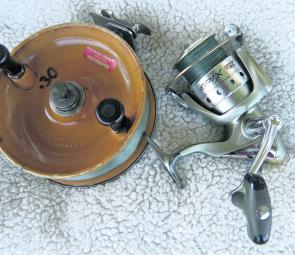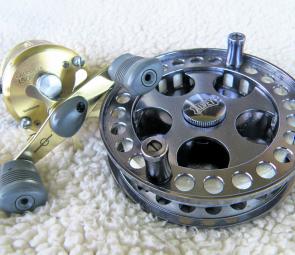Line twist is a common complaint amongst anglers and it can happen in just two ways.
Firstly, if a bait or a soft plastic is not mounted on a hook or jighead correctly, it is likely that it will corkscrew its way through the water when being trolled or retrieved. Secondly, twisting might occur depending on the type of reel being used. In the casting process, line leaves the spool either directly off the moving spool, or in coils off the face of the reel. In retrieval, line comes back onto the reel either directly onto the spool being rotated or in coils guided onto the spool by the bail arm. If the processes of casting and of retrieval are the same, the type of reel should not be a problem. If they are not the same, a twist will be generated for each length of line equal to the effective circumference of the spooled line.
It should be pointed out that a line, no matter what type or specification, is never the cause of line twisting. However the effect of line twisting, but not the degree, can be affected by a physical characteristic known as memory. Lines with high memory tend to ‘remember’ the shape of a spooled line, a packaged rig, or a twist that it has acquired. On the other hand, low memory lines are less prone to these situations.
Of the commonly used lines, monofilaments can have varying degrees of memory, sometimes noted on the packaging. Low memory is usually associated with limpness and this makes this the most desirable characteristic in most fishing situations. Monos that are particularly abrasion-resistant might also lend to have high memory.
When choosing a monofilament, these properties, as well as factors like line diameter, breaking strain and stretch, should be taken on board. It is the molecular structure of the particular polymer that determines all of these characteristics. Of course, the reputation of the manufacturer should not be overlooked.
Braided lines have almost no memory at all, but going with this they have almost no stretch and are very limp. For most applications these are the desirable characteristics that makes it so popular today.
Fluorocarbons, however, have typically high memory and tend to be stiff with high abrasion-resistance. Most importantly fluorocarbons have refractive indices close to that of water, making them almost invisible in the water. These properties make them ideal for leaders and traces, but not for main lines in most fishing situations (bream fishers love using fluorocarbon straight through in certain situations).
At this point we should make the distinction between twisting and coiling. The latter is a characteristic of high memory lines where line wound onto a spool, in time takes up the shape of the spool. All monofilaments have a degree of memory and this is exacerbated by the age of the line and probably the conditions under which it is stored. Although coiling is not twisting it can certainly cause problems in all types of reels.
Baitcasters and big brother game reels have the least problem with line twist, as line leaves the reel the same way it is retrieved. That is both casting and retrieval involves the rotating spool. Only user factors, already mentioned, should be significant here.
On first consideration, we might not expect line twist to be a problem with spinning reels, as in casting the line comes off the face of the spool in coils, and in retrieval, the coils are replaced by the bail arm. However there are circumstances where this does not happen. When a fish takes line off the reel under drag, or in the operation of a bait runner, this line comes directly off the rotating spool, just as it does off a baitcaster. So the imbalance can cause significant twisting of the line.
It is in the side cast reel that most twisting problems arise as the line leaves the fixed spool in coils and is brought back onto the spool directly. This is acknowledged by Alvey Reels, the manufacturer of this popular reel. They give some very good advice about minimising the problem. Most importantly the first piece of terminal tackle the line contacts must be a swivel. It must be a good match for the line and one that is not clogged up with corrosion.
There are lots of swivel varieties including barrel, bullet, crane and ball bearing. Putting aside their own particular characteristics, they have one task in common – to remove twisting from lines as they are being retrieved. To do this each eye must be able to rotate freely relative to the other. No doubt some of the more expensive ball bearing varieties might do a better job in specialised situations but for most of us, the inexpensive barrel swivels work well provided they are in good condition.
There are many ideas about matching line diameter to swivel size. The line being untwisted needs to be powerful enough to allow the loops of the swivel to rotate relative to each other. Generally I like to use a small number 12 swivel with a typical whiting line of about 0.25mm diameter. With a 0.45mm line a larger swivel of number 6 or 8 would match it well.
The degree of line twisting due to different processes of casting and retrieval is related to the effective diameter (and hence circumference) of the spooled line. A 650 Alvey would typically carry a 14cm diameter line spool. Each coil of line leaving the spool would be approximately 44cm in length and this would produce a single twist. A 20m cast from this reel would result in 45 twists. For a 500 series Alvey with a 10cm diameter line spool, a 20m cast would produce around 63 twists. So smaller diameter reels produce more line twists. With the correct use of a suitable and freely moving swivel, such twists would be removed on retrieval of the line. However other factors might come into play.
If there is weed in the water, this might catch around the swivel, preventing it from doing its job. As already mentioned, a poorly mounted pilchard on a gang of hooks will often spin on retrieval. The same might well apply to the way a plastic is threaded onto a jighead. If simply used as a sinker-stop, particularly a heavy one, the swivel may be rendered useless. In a typical surf rig, a second swivel might be employed as a sinker stop for convenience, but in this application it hardly serves the purpose for what is intended. A solid ring could be used as effectively.
When a line is allowed to develop serious twisting, the memory of the line comes into play just as it does in coiling. A high memory line will remember twists and cause problems in both casting and retrieval where a low memory product will still form twists but they are likely to be more manageable in the short term.
Once a line has developed serious twisting, regardless of the memory rating, it should be discarded.
Minor twisting can be overcome to an extent by allowing the line to unwind. This is easily done by running the bare line out behind a boat travelling at a low speed for a short time. This gives the line the opportunity to throw the twists. If the boat speed is too high there is the chance of over-stretching and weakening the line.
To test whether the twists have been removed, hold a length of line in two hands forming a U shaped loop. Slowly bring the sides of the loop together. If they come together without any tendency to wind around each other, then the operation has been successful.
On the beach, the same result can be obtained by walking through the water’s edge and running the affected line out behind you for as much time as it would seem necessary.
By far the most serious examples of line twist are seen on the ocean beach where long casts from side-cast reels as well as poor preparation of terminal tackle and bait are the contributing factors. It is much more difficult to reduce twisting in high memory monos.
As many readers would know I have a particular addiction to luderick fishing. I have been using one of Alvey’s side cast Blackfish reels since it was first manufactured. I have always been glad of the side cast action in obtaining the longer casts that are often required around the headlands and from some of the sea walls. However I have frequently been frustrated with line twist, despite the fact that I always purchase low memory mono.
Another problem has been that in a Blackfish rig, the main line runs through the eyes of the float before reaching the swivel. The float itself can hamper the effect of the swivel in taking out the twisting. Neverthess, I am now the proud owner of Alvey’s latest in the Blackfish stable – the 475CP engineered in cold-forged aluminium and top quality sealed stainless steel bearings.
Looking not unlike a fly reel, the 475CP has a smooth almost friction-free spool. Being a fixed spool reel requiring direct casting as well as direct retrieval, I needed to employ a casting method that would place my rig a fair distance from the shore, and with great accuracy. The Wallis cast has been around for a long time, but it was certainly new to me. The general principle of the cast is that line is stripped from the reel, putting the spool into motion. This all happens in conjunction with the casting action so that the departing rig takes line off the free spinning reel, rather than one that is stationary.
Sounds easy? For some, maybe, but for me it came slowly. To get me started I found a number of sites through Google. Possibly the most helpful was at http://www.youtube.com/watch?v=7YgGnyqr8iA where John Newberry demonstrates the art of Wallis casting. In this video he uses an older centre-pin reel but I note that more recently, he has used and given his enthusiastic support to the new Alvey. For sheer simplicity, this beautifully engineered reel is a delight to use and I am now experimenting with its use in other light gear applications.
Reads: 9405
Both of these reels (Alvey and threadline) will twist your line. The Alvey creates twist as the line comes off the spool in a different manner to how it is retrieved back onto the spool. The threadline runs into issues when fish take drag.

Direct casting reels like this overhead and Alvey Blackfish reel rarely encounter line twist as line is removed and deposited on the spool in the same manner. Line twist will come from retrieving lures or baits that are spinning in the water.




